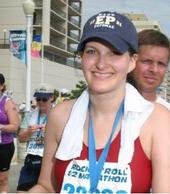Why fitness and philanthropy is such a popular mix.
By Sally Wadyka for MSN Health & Fitness
When breast cancer survivor Eloise Caggiano decided to participate in last year’s 3-Day Walk, she was excited both to raise money for a cause so close to her heart and take on a significant physical challenge. “Walking 60 miles is a true commitment of time and physical effort,” she says. And since the walk requires participants to raise at least $2,200, “everyone who does it is really passionate about the cause.”
But passion for a particular cause is just one of the many reasons why events that combine running, walking, or biking with raising money have become so incredibly popular in recent years. The ubiquitous Team in Training is one of this trend’s prime movers. The program, which began in 1988, trains people to participate in endurance events—like marathons and 100-mile bike rides—while they raise money for the Leukemia & Lymphoma Society. Participants get the benefit of professional coaching, personalized training schedules and team support. And the Society gets an influx of funds to help support research, patient education and other services. In fact, since its inception, more than 350,000 people have participated in Team in Training and together they’ve raised $800 million.
“People join the program for a variety of reasons—the social aspect, the camaraderie of being part of a team, getting fit, pushing themselves to accomplish a goal, and contributing to a good cause,” says Andrea Greif, director of public relations for the Leukemia & Lymphoma Society.
And while Team in Training attracts both men and women, more and more women are using such philanthropic programs as their entry into endurance events. In fact, some events cater just to women—the Nike Women’s Marathon, for example, benefits the Leukemia & Lymphoma Society in San Francisco. This October marks the fourth running of the event, which features a women’s-only full marathon and half marathon. While the Nike race doesn’t require everyone to fundraise for the cause, so far participants have raised $40 million for the Society.
Perhaps one of the reasons why more women are getting involved is that many of these events cater to causes close to their hearts. A prime example, of course, is breast cancer. The Komen Race for the Cure—which has been running for 24 years—is now the largest series of 5-K races in the world. It began in 1983 in Dallas with 800 participants. Now there are Race for the Cure events in 115 cities that get more than one million people involved.
Fundraising is obviously important, but the bigger goal of Race for the Cure is educational. “We want to make sure that every single participant in the Race to takes home valuable information about breast health, and that they share that information with their family and friends,” says Melissa Aucoin, manager of the Komen Race for the Cure.
A 5-K race (3.1 miles) is not an endurance event, but that is part of the point. “It’s a distance that appeals to both runners and walkers, and it’s a very achievable goal,” Aucoin says. While the majority of participants are women, the events are designed to be family friendly—the 5-K is open to men and women, and many events feature fun runs for kids. “The passion of hundreds of survivors and their friends and family is contagious, and I think it motivates and inspires even more people to get involved,” says Aucoin.
Even when you have no connection to a cause, charity events often lure athletic wannabes to push their physical limits. The MS Bike Ride—which varies in length from a 30-mile one-day ride to multi-day events that cover a couple hundred miles—routinely attracts those new to the sport. “People are drawn to the Ride because it’s a well-organized, well-supported event,” says Betty Ross, associate vice president of campaign development for the National MS Society. “A lot of people who are looking to do a long ride for the first time join in and let us worry about the details.” Of course, once they get involved, they often find themselves more connected to the cause. Participants are required to raise a minimum amount (which varies by race from $250 to $400). “During the fundraising process, they might discover that they do know someone who has the disease and start to feel a more personal connection to our mission,” says Ross.
Another possible reason for the increase in popularity of fitness-oriented fundraising is that the Internet has made the process much easier. Asking for money from friends, neighbors, and co-workers face-to-face has been replaced with emails and personalized fundraising Web sites. One site, Firstgiving.com, is dedicated entirely to fundraising—regardless of the cause. So if you decide to run a marathon that isn’t affiliated with a specific charity, you can set up a page on this Web site, personalize with your story and the details about the cause you’re supporting, and email the link to friends and family. They can go online, donate by credit card, and Firstgiving automatically transfers the funds to the nonprofit.
Regardless of what initially attracts people to join, few finish their event without being moved by the experience. “It started as a way to get in shape and run my first marathon,” says Team in Training alum Seth Eisen. “But from meeting new friends, connecting with people affected by the tragedy of blood cancers, to becoming a runner for life, the Team in Training experience was more than I ever could have expected.”
Sally Wadyka is a Boulder, Colo.-based freelance writer who writes regularly for Shape, Runner’s World, Real Simple and The New York Times.
Monday, August 13, 2007
Subscribe to:
Post Comments (Atom)

No comments:
Post a Comment